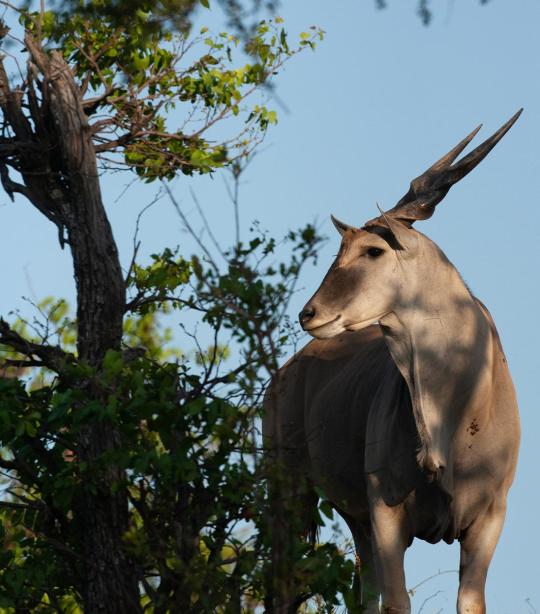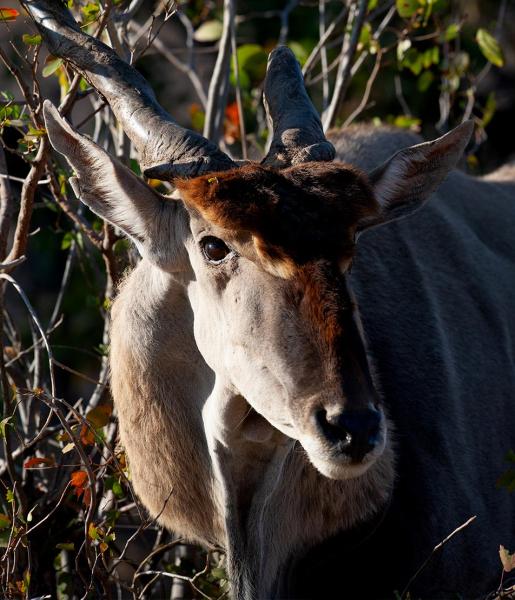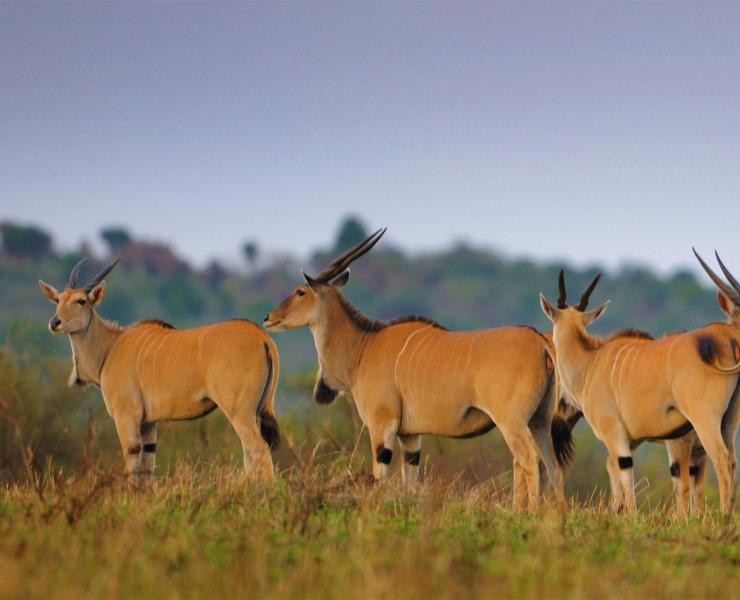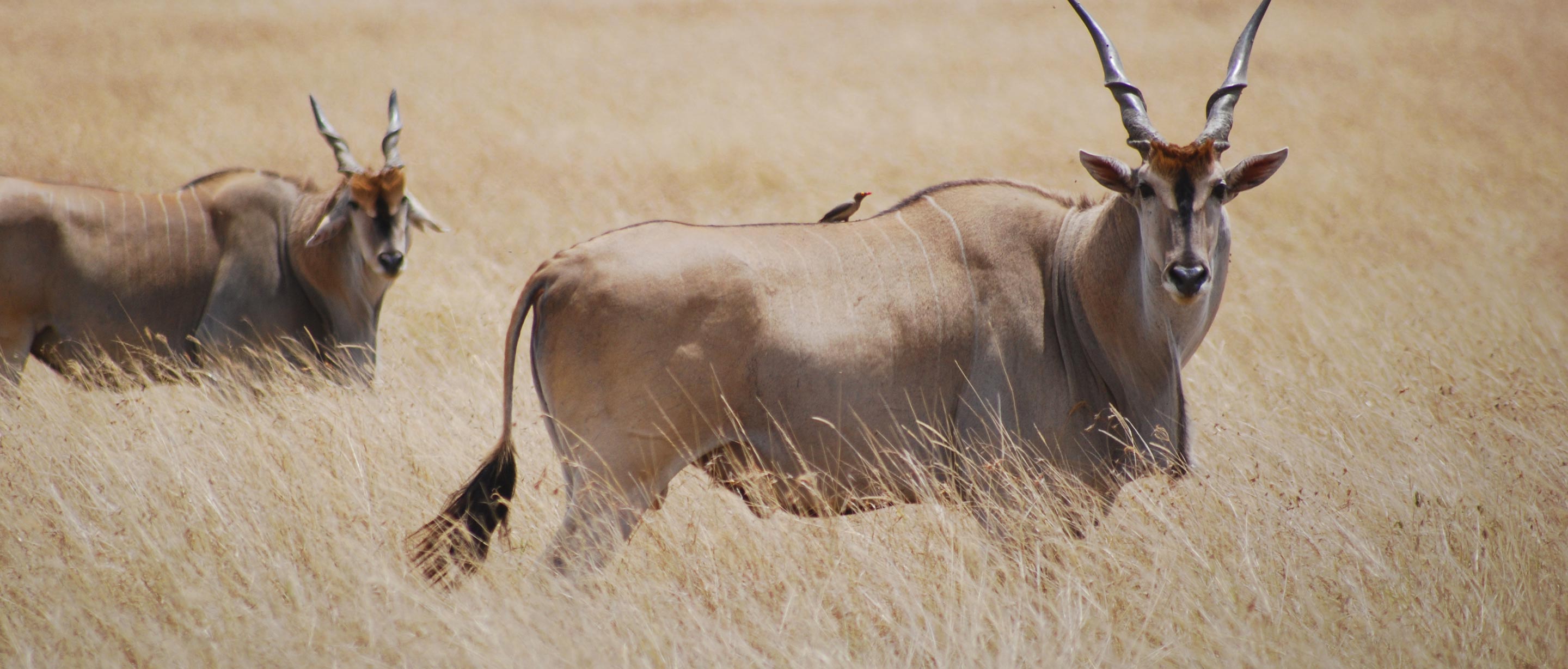What is an eland?
The cow-like eland is the world’s largest antelope. However, it has the endurance to maintain a trot indefinitely and can jump a 1.5 meter (4 feet) fence from a standstill. Both males and females have horns that spiral tightly, though female horns tend to be longer and thinner. Usually fawn or tawny-colored, they turn gray or bluish-gray as they get older; the oldest animals become almost black. A tuft of black hair grows out of the male’s prominent dewlap, the loose fold of skin that hangs down from the neck. Adult males also have a mat of hair on the forehead that grows longer and denser as the animal ages.
Tragelaphus oryx
590 to 997 kilograms (1,300 to 2,200 pounds)
Male: 2 to 3 meters in length (7 to 11 feet) Female: 1 to 3 meters in length (6 to 9 feet) Both: About 2 meters at the shoulder (6.5 feet)
15 to 20 years
Open plains, sub-desert, savanna, and woodlands
Herbivorous
About 9 months
Humans, lions, and African hunting dogs

Challenges
Elands have experienced population decline due to hunting.
Their rich milk, tasty meat, and useful hides have made them popular ranch animals and hunting targets. Their meat is highly prized, especially by illegal hunters, because each animal provides a large quantity of meat. The world’s largest antelope is becoming widely domesticated due to their high yield of nutritious ‘long life’ antibacterial milk — which also has much higher protein content and milk fat than cow’s milk — in Zimbabwe, South Africa, and Kenya. However, only one attempt to domesticate these antelopes has been successful due to the high food supplemental costs, confining them at night, and herding them during the day.
Human and livestock expansion destroy eland habitats.
As human populations are growing and expanding settlements and agriculture, they are encroaching on elands living spaces and destroying habitats and food sources. They have been eliminated from more than 50 percent of their historic range due to human encroachment, and since the 1970s, their population decreased dramatically because of civil wars and its aftermath in countries such as Uganda, Rwanda, Angola, and Mozambique.
Solutions
Our solutions to protecting the eland:
African Wildlife Foundation brings together private investors with local communities to construct conservation tourism lodges, like The Sanctuary at Ole Lentille, in Kenya. The lodge provides sustainable income for the community and the 20,000-acre conservancy is a safe home to elands and other wildlife.
AWF works with governments and villages to designate wildlife corridors — large swaths of land that elands can use to roam freely and safely from one park, or country, to another. Corridors link protected areas and allow elands to follow rains or travel to their calving grounds.


Behaviors
Older males tend to be more solitary.
The social organization of the eland is somewhat different from that of other antelopes. The older the male is more solitary, while younger animals may form small groups. Males are also more sedentary than females, who may travel widely, especially during the dry season. Females and young are found in loosely cohesive groups. Calves spend a lot of time grooming and licking each other, developing bonds even stronger than those of calf with its mother.
Eland young are born year round.
Females with young calves come together in nursery groups. After the young are weaned at about three months, the mothers rejoin the female herds and the calves remain together in the nursery group. With year-round births, some adult females are always present in a nursery group and they defend all juveniles present, not just their own. Juveniles usually remain in the nursery groups until they are almost two years old when they begin to wander off and join other loose groupings of their sex.
Diet
Elands prefer a vegetarian diet.
They browse more than they graze, feeding in areas where shrubs and bushes provide the leaves they prefer and using their horns to bring twigs and branches into reach. They also consume certain fruits, large bulbs, and tuberous roots. Water is consumed voraciously when it is available, but they can go with minimal to no water during the dry season.
Habitats
Where do elands live?
Common elands are one of the most adaptable ruminants and are found in grassland, mountain, acacia savanna, and miombo woodland areas. They distance themselves from deserts, forests, and swamps.



